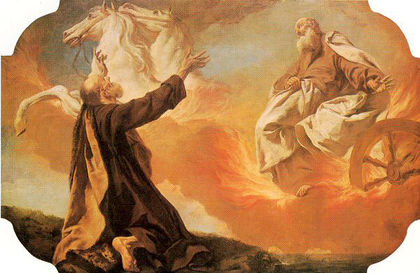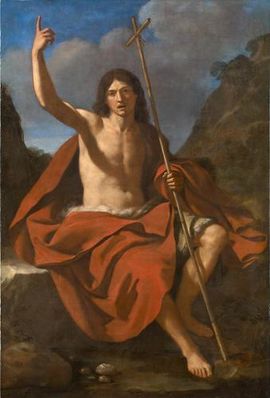John the Baptist/es: Difference between revisions
(Created page with "''Juan el Bautista'', Guercino (1641)") |
(Created page with "== Juan el Bautista ==") |
||
| Line 12: | Line 12: | ||
[[File:Guercino 006.jpg|thumb|upright=0.9|''Juan el Bautista'', Guercino (1641)]] | [[File:Guercino 006.jpg|thumb|upright=0.9|''Juan el Bautista'', Guercino (1641)]] | ||
== | == Juan el Bautista == | ||
After his ascension, Elijah received the almost unique dispensation that enabled him to reembody; and so he came again as John the Baptist to “prepare the way of the Lord.” He willingly took on a flesh form and allowed himself to be sacrificed at the hand of Herod, in order to assist his disciple to fulfill his mission. | After his ascension, Elijah received the almost unique dispensation that enabled him to reembody; and so he came again as John the Baptist to “prepare the way of the Lord.” He willingly took on a flesh form and allowed himself to be sacrificed at the hand of Herod, in order to assist his disciple to fulfill his mission. | ||
Revision as of 03:09, 3 March 2020

El maestro ascendido Juan el Bautista tuvo dos encarnaciones de las que hay constancia en la Biblia: el profeta del Antiguo Testamento Elías y Juan el Bautista del Nuevo Testamento. El propio Jesús declaró que Juan el Bautista era Elías venido de nuevo.Cite error: Invalid <ref> tag; refs with no name must have content
Elías y Eliseo
La historia de Elías el tisbita y su discípulo Eliseo (una anterior encarnación de Jesús) se encuentra en el libro de Reyes, donde la ascensión de Elías se describe de esta forma: «Un carro de fuego con caballos de fuego apartó a los dos; y Elías subió al cielo en un torbellino»Cite error: Invalid <ref> tag; refs with no name must have content.
Después de que Eliseo presenciara la ascensión de su instructor, asumió «el manto de Elías que se le había caído» y golpeó las aguas del Jordán. Cuando las aguas se separaron y Eliseo pasó entre ellas, los hijos de los profetas vieron que el espíritu de Elías descansaba sobre Eliseo. Desde ese momento, Eliseo hizo muchos milagros, hazañas de alquimia proféticas del triunfo de su Espíritu sobre la materia durante su última encarnación como Jesús. Los relatos en los que Eliseo cura las aguas, multiplica el aceite de la viuda, abre el vientre de la sunamita y después resucita a su hijo de los muertos, la multiplicación de los panes de cebada y la curación de Naamán de lepra constan en el segundo libro de Reyes junto con otras demostraciones de la Ley por parte de este «Hombre de Dios».

Juan el Bautista
After his ascension, Elijah received the almost unique dispensation that enabled him to reembody; and so he came again as John the Baptist to “prepare the way of the Lord.” He willingly took on a flesh form and allowed himself to be sacrificed at the hand of Herod, in order to assist his disciple to fulfill his mission.
The relationship of Jesus and John the Baptist is a story of great devotion, love and respect—beautiful to behold and seldom equaled. It is the story of the guru-chela, master-disciple relationship. Being the great and humble teacher that he was, John said of Jesus, “He must increase, but I must decrease”[1]; for he bore in his heart the great God-desire that Jesus should exceed him in attainment and in service. He wanted to remain in the background, to see the glory—the full mantle of his ascended consciousness—upon Jesus. After his lifetime as John the Baptist, he returned to the ascended state.
His service today
The ascended master John the Baptist says:
There must be a meeting ground for heaven and earth, and that is the place of the heart. Your heart is the receiver of God, of Christed ones; and the womb of the Divine Mother is the recipient of the seed of Alpha for the birth of the Divine Manchild. Therefore, as Christed ones, welcome the King of kings and Lord of lords into your heart! As flames of the Divine Mother, cherish the incarnation of the Christ!
It is the materialization of the God flame that we pursue to make earth a haven of light that all mankind might know the kingdom of God within and without, the conformity of sacred law.[2]
Sources
Mark L. Prophet and Elizabeth Clare Prophet, The Masters and Their Retreats, s.v. “Elijah (John the Baptist).”
